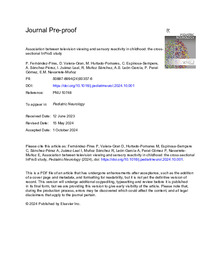Por favor, use este identificador para citar o enlazar este ítem:
https://hdl.handle.net/11000/34741Registro completo de metadatos
| Campo DC | Valor | Lengua/Idioma |
|---|---|---|
| dc.contributor.author | Fernández Pires, Paula | - |
| dc.contributor.author | Valera Gran, Desireé | - |
| dc.contributor.author | HURTADO-POMARES, MIRIAM | - |
| dc.contributor.author | Espinosa-Sempere, C. | - |
| dc.contributor.author | Sánchez-Pérez, A. | - |
| dc.contributor.author | Juárez Leal, Iris | - |
| dc.contributor.author | Muñoz Sánchez, R. | - |
| dc.contributor.author | León-García, A.S. | - |
| dc.contributor.author | Peral-Gómez, P. | - |
| dc.contributor.author | Navarrete-Muñoz, Eva María | - |
| dc.contributor.other | Departamentos de la UMH::Patología y Cirugía | es_ES |
| dc.date.accessioned | 2025-01-16T19:41:59Z | - |
| dc.date.available | 2025-01-16T19:41:59Z | - |
| dc.date.created | 2024-10-01 | - |
| dc.identifier.citation | Pediatr Neurol . 2024 Dec:161:255-261 | es_ES |
| dc.identifier.issn | 0887-8994 | - |
| dc.identifier.uri | https://hdl.handle.net/11000/34741 | - |
| dc.description.abstract | Current evidence suggests a potential detrimental effect of increased television viewing on children’s health, including sensory processing issues. Therefore, this study examined the association between television viewing time and atypical sensory reactivity (SR) in children aged from 3 to 7 years. We evaluated data from the InProS cross-sectional study (n=545). Daily television viewing was categorized into tertiles: ≤ 1.5, 1.5-2.5, and ≥ 2.5 hours. SR was evaluated using the Short Sensory Profile (SSP). Children with atypical SR were those with the global SSP score below 155, 30 for tactile sensitivity, 15 for taste/olfactory sensitivity, 13 for movement sensitivity, 27 for under-responsive/seeks sensation, 23 for auditory filtering, 26 for low energy/weak, and 19 for visual/auditory sensitivity. We used multiple Poisson regression models with robust variance to explore associations. After adjusting for covariates, children who watched television 1.5-2.5 and ≥ 2.5 hours/day showed a higher prevalence of atypical global SR (PR:1.54; 95%CI: 1.03-2.30; PR:1.81; 95%CI: 1.19-2.76, respectively) and auditory filtering (PR:1.50; 95%CI: 1.15-1.96; PR:1.36; 95%CI: 1.01-1.83, respectively), compared to children who watched ≤ 1.5 hours/day. In addition, watching television ≥ 2.5 hours/day, compared to watching ≤ 1.5 hours/day, was associated with having atypical SR in movement sensitivity (PR:1.73; 95%CI: 1.06-2.83), under-responsive/seeks sensation (PR:1.31; 95%CI: 1.02-1.69), and low energy/weak (PR:2.02; 95%CI: 1.01-4.06). The findings showed that television viewing ≥1.5 hours/day was associated with a higher prevalence of atypical SR in childhood. However, further longitudinal studies are required to confirm these results. | es_ES |
| dc.format | application/pdf | es_ES |
| dc.format.extent | 24 | es_ES |
| dc.language.iso | eng | es_ES |
| dc.publisher | Elsevier | es_ES |
| dc.rights | info:eu-repo/semantics/openAccess | es_ES |
| dc.rights | Attribution-NonCommercial-NoDerivatives 4.0 Internacional | * |
| dc.rights.uri | http://creativecommons.org/licenses/by-nc-nd/4.0/ | * |
| dc.subject | children | es_ES |
| dc.subject | sensory reactivity | es_ES |
| dc.subject | television viewing | es_ES |
| dc.subject | sensory processing difficulties | es_ES |
| dc.subject | sedentary behavior | es_ES |
| dc.title | Association between television viewing and sensory reactivity in childhood: the cross- sectional InProS study | es_ES |
| dc.type | info:eu-repo/semantics/article | es_ES |
| dc.relation.publisherversion | 10.1016/j.pediatrneurol.2024.10.001 | es_ES |

Ver/Abrir:
Association between television viewing and sensory reactivity in childhood the crosssectional InProS study.pdf
1,43 MB
Adobe PDF
Compartir:
 La licencia se describe como: Atribución-NonComercial-NoDerivada 4.0 Internacional.
La licencia se describe como: Atribución-NonComercial-NoDerivada 4.0 Internacional.
.png)